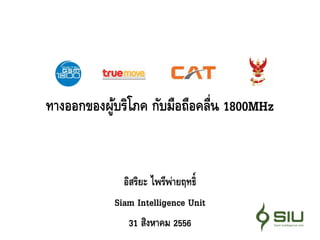Thailand 1800MHz Frequency Management
- 1. ทางออกของผูบริโภค กับมือถือคลื่น 1800MHz ้ อิสริยะ ไพรีพายฤทธิ์ ่ Siam Intelligence Unit 31 สิงหาคม 2556
- 2. จานวนลูกค้ามือถือ 1800MHz (ไม่รวม dtac) 17 ล้านราย ~100,000 ราย
- 3. Ireland Case Study Romania Case Study http://www.financial- magazine.org/the-new-minister- of-communications-mobile- licenses-auction-will-take-place- without-romanian-inventions- 68193.html
- 4. Frequency Operation Infrastructure User Handset 2555 2556
- 5. ลูกค้ารูปญหาหรือไม่? ้ั ย้ายค่ายล่วงหน้า รู ้ ย้ายเมือสิ้นสัญญา ่ ไม่รู ้ ใช้ถง ก.ย. 56 ึ กสทช. และโอเปอเรเตอร์ ต้องทาให้ผูใช้มือถือรูเ้ รื่องการหมดอายุสมปทานให้เร็วที่สด ้ ั ุ
- 6. ย้ายข้ามค่าย ย้ายไปบริการอืนในค่ายเดียวกัน ่ ย้ายไปยังเจ้าของสัมปทาน ย้ายไปโอเปอเรเตอร์ใหม่ 1800MHz ???
- 7. (1) ย้ายข้ามค่าย •ผ่านระบบ Mobile Number Portability (MNP) •มีค่าบริการ 99 บาท •ใช้เวลา 3 วัน •มีข ้อจากัดเรื่องความจุของระบบ MNP 400 ราย/operator/วัน •1 ปี ย้ายได้ 400x365 = 156,000 เลขหมาย? •เงินทีเ่ ติมค้างในระบบ? •อาจต้องเปลียนเครื่อง? ่
- 8. (2) ย้ายไปบริการอืนในค่ายเดียวกัน ่ •รูปแบบคล ้ายข้อแรก คือย้ายบริการ ค่ายเดิม •ผ่านระบบ MNP มีขอจากัดเรื่องปริมาณ ้ •อาจมีโปรโมชันค่าโทร-ค่าเครื่องให้บา้ ง ่ •เงินทีเ่ ติมไว้ในระบบเดิม? •อาจต้องเปลียนเครื่อง? ่ (โดยเฉพาะ TrueMove H)
- 9. เพิ่มค่าโทรให้ 240 นาที 3 เดือน ไม่มีโปรค่าเครื่อง
- 10. (3) ย้ายไปยังเจ้าของสัมปทาน •ย้ายก่อนหมดสัมปทาน และย้ายหลังหมดสัมปทาน •ต้องผ่านระบบ MNP กรณียา้ ยก่อนหมดสัมปทาน? •ยังไม่เห็นความชัดเจน เรื่องโปรโมชัน ่ •ต้องเปลียนเครื่องใน ่ กรณีของ My •CAT บริหารลูกค้า 17 ล ้านรายไหวหรือไม่
- 11. (4) ย้ายไปโอเปอเรเตอร์ใหม่ 1800MHz •เป็ นไปได้วา กสทช. อาจกาหนดให้ผูชนะการประมูล 1800MHz ่ ้ ต้องให้บริการลูกค้าในระบบ 1800MHz เดิมได้ •อาจเป็ นวิธแก้ปญหาสาหรับลูกค้าทีไม่ยอมย้ายจนกระทัง่ หมด ี ั ่ สัมปทาน และใช้เครื่องเดิม •โครงข่าย 2G จะบริหารอย่างไร? เช่าต่อจาก CAT? •ถ้ารายเดิม (AIS/TRUE) ได้คลืนเดิม แก้ปญหาง่าย ่ ั •ถ้ารายใหม่ได้คลืน ต้องมีแผนการเปลียนผ่าน > ขึ้นกับช่วงเวลาของ ่ ่ การประมูล
- 12. สรุป •กสทช. TRUE GSM1800 CAT ต้องแจ้งลูกค้า โดยเร็วว่าสัมปทานหมดอายุ ก.ย. 2556 •จัดประมูลคลืน 1800MHz ให้เร็วทีสุดเท่าทีเ่ ป็ นไป ่ ่ ได้ เพือขยายเวลาช่วงเปลียนผ่านบริการก่อน ก.ย. ่ ่ 2556




























































